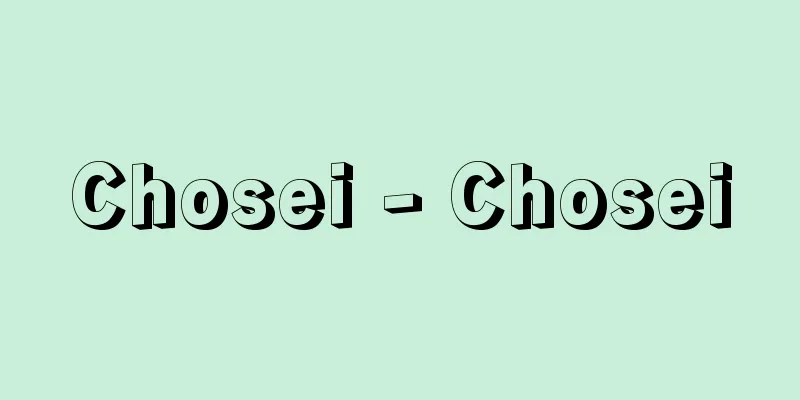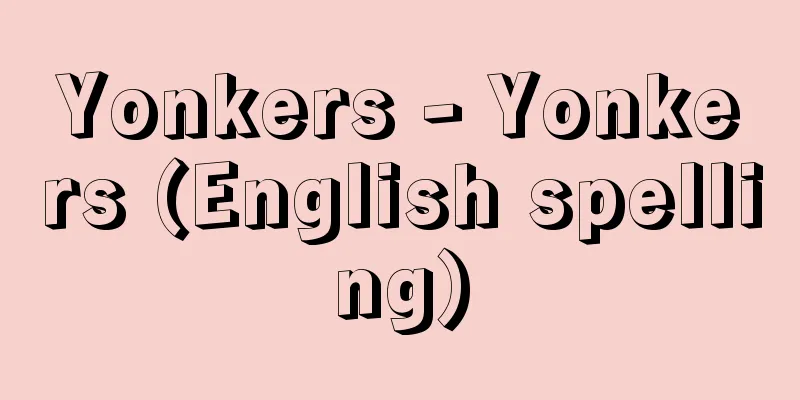Chosei - Chosei

|
Year of death: November 9, 5th year of Kanji (December 21, 1091) Year of birth: Kanko 7 (1010) A Buddhist sculptor from the mid-Heian period. Also written as Chosei. He is said to have been a disciple of Jocho and the father or teacher of Ensei. Together with Jocho's eldest son, Kakusuke, he was a central figure in the world of statues after Jocho's death, and later founded the Sanjo Buddhist Temple (En school) in Kyoto. His achievements began with his participation in the reconstruction of Hosho-ji Temple, which had been burned down in 1058, and he was conferred the title of Hokkyo in 1065 for his statues. In 1070, he became a Hokan after creating the 6-foot-tall Vairocana Buddha and Yakushi Nyorai Buddha for the Kondo (Golden Hall) of Ensoji Temple, as well as the 6-foot-tall statues of Ichiji Kinrin, Bonten, Taishakuten, and the Four Heavenly Kings, and in 1077, he was promoted to Hoin for his achievements in creating the statues for the lecture hall and Amida Hall of Hosho-ji Temple. Although only records remain of the works of formal Buddhist sculptors from the late Heian period, and few actual examples remain, the statues of Nikko and Gakko Bosatsu and the Twelve Heavenly Generals at Koryuji Temple in Kyoto are said to have been created by Nagase in 1064, and their elegant and powerful style is worthy of being a direct disciple of Jocho, the perfected Fujiwara style. <References> Kobayashi Tsuyoshi, "Buddhist Sculptor Hoin Nagase" (Research on Japanese Sculptors) (Kazuharu Asai) Source: Asahi Japanese Historical Biography: Asahi Shimbun Publications Inc. About Asahi Japanese Historical Biography |
|
没年:寛治5.11.9(1091.12.21) 生年:寛弘7(1010) 平安中期の仏師。長成とも書く。定朝の弟子,円勢の父または師と伝えられる。定朝の嫡男である覚助と共に定朝没後の造像界をになった中心的な人物で,のちに京都三条仏所(円派)を開いた。その活躍は,天喜6(1058)年に焼失した法成寺復興事業に参加したことに始まり,その造仏により治暦1(1065)年に法橋に叙された。延久2(1070)年には円宗寺金堂の2丈の毘盧舎那仏と薬師如来,および一字金輪,梵天,帝釈天,四天王の各丈六像を造って法眼となり,承暦1(1077)年には法勝寺講堂および阿弥陀堂の諸像制作の功で法印に上った。平安時代後期の正系仏師の作品はその記録のみで実作例は殆ど遺っていないが,現存する京都・広隆寺の日光・月光菩薩および十二神将像は康平7(1064)年に長勢が造った作品と伝えられ,その典雅で力強い作風は,藤原様式の大成者である定朝の直弟子として恥じないものといえる。<参考文献>小林剛「仏師法印長勢」(『日本彫刻作家研究』) (浅井和春) 出典 朝日日本歴史人物事典:(株)朝日新聞出版朝日日本歴史人物事典について 情報 |
<<: Asama government - Asama government
Recommend
Konoe Kanetsune
Year of death: May 4, 1259 (May 27, 1259) Year of ...
Stone Age
One of the three ages proposed by the Danish auth...
Cedar waxwing (English spelling)
…They breed in southeastern Siberia and migrate t...
Kukuinoki - Kukuinoki
…Palm oil is made from the endosperm of the cocon...
Andersen-Nexe, M. - Andersen-Nexe
…Danish author. Also known as Andersen Nexe or An...
Emancipists
These are the convicts and pardoned people who fou...
Ormuzd - Ormuzd
...Of course, the art of the early Sassanid Empir...
Gottlieb, A. (English spelling) GottliebA
...A group of abstract art that developed in the ...
Paulus Diaconus (English spelling)
…It is also worth noting that England had two poe...
Minamoto no Toshikata
Year of death: Manju 4.6.13 (1027.7.19) Year of bi...
Cadmeia - Cadmeia
…When his sister Europa was abducted by Zeus, he ...
Haplotaxidae
…There are about 20 species in Japan, with the cr...
Kakidooshi
Nutrition, Functions & Cooking Tips A perenni...
Great-grey kangaroo
An animal of the Marsupial order of the Mammalia ...
Shiga Prefecture
A prefecture in the northeastern part of the Kinki...









